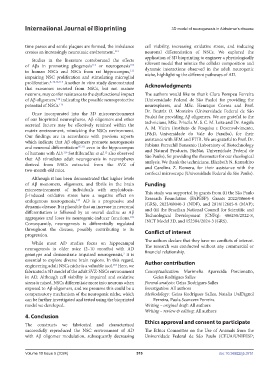Page 527 - IJB-10-5
P. 527
International Journal of Bioprinting 3D model of neurogenesis in Alzheimer’s disease
time passes and senile plaques are formed, the imbalance cell viability, increasing oxidative stress, and inducing
creates an increasingly neurotoxic environment. 111 neuronal differentiation of NSCs. We explored the
Studies in the literature corroborated the effects application of 3D bioprinting to engineer a physiologically
of Aβs in promoting gliogenesis or neurogenesis relevant model that mimics the cellular composition and
112
102
in human NSCs and NSCs from rat hippocampus, dynamic interactions observed in the adult neurogenic
111
impairing NSC proliferation and stimulating microglial niche, highlighting the different pathways of AD.
proliferation. 8–10,12,113 Another in vitro study demonstrated Acknowledgments
that exosomes secreted from NSCs, but not mature
neurons, may confer resistance to the dysfunctional impact The authors would like to thank Clara Pompeu Ferreira
of Aβ oligomers, indicating the possible neuroprotective (Universidade Federal de São Paulo) for providing the
114
potential of NSCs. 115 neurospheres, and MSc. Henrique Correa and Prof.
Dr. Beatriz O. Monteiro (Universidade Federal de São
Once incorporated into the 3D microenvironment
of our bioprinted neurospheres, Aβ oligomers and other Paulo) for providing Aβ oligomers. We are grateful to the
technicians, MSc. Priscila M. S. C. M. Leite and Dr. Angela
secreted factors may be effectively retained within the A. M. Vieira (Instituto de Pesquisa e Desenvolvimento,
matrix environment, mimicking the NSCs environment. IP&D, Universidade do Vale do Paraíba), for their
Our findings are in accordance with previous reports assistance with SEM and FTIR. We are grateful to Prof. Dr.
which indicate that Aβ oligomers promote neurogenesis Fabiana Perrechil Bonsanto (Laboratory of Biotechnology
and neuronal differentiation 85,111 even in the hippocampus and Natural Products, BioNat, Universidade Federal de
of humans with AD. Sotthibundhu et al. also observed São Paulo), for providing the rheometer for our rheological
12
116
that Aβ stimulates adult neurogenesis in neurospheres analysis. We thank the technicians, Elizabeth N. Kanashiro
derived from NSCs extracted from the SVZ of and Carolina Z. Romera, for their assistance with the
two-month-old mice.
confocal microscope (Universidade Federal de São Paulo).
Although it has been demonstrated that higher levels
of Aβ monomers, oligomers, and fibrils in the brain Funding
microenvironment of individuals with amyloidosis-
β-induced oxidative stress have a negative effect on This study was supported by grants from (i) the São Paulo
117
endogenous neurogenesis, AD is a progressive and Research Foundation (FAPESP): Grants 2022/08664-4
dynamic disease. It is plausible that an increase in neuronal (GRS), 2023/08040-3 (NDF), and 2018/12605-8 (MAP);
differentiation is followed by an overall decline as Aβ and (ii) the Brazilian National Council for Scientific and
aggregates and loses its neurogenic-inducer functions. Technological Development (CNPq): 406258/2022-8,
109
Consequently, neurogenesis is differentially regulated INCT Model 3D, and 152384/2024-3 (GRS).
throughout the disease, possibly contributing to its
progression. Conflict of interest
The authors declare that they have no conflicts of interest.
While most AD studies focus on hippocampal
neurogenesis in older mice (2–10 months) with AD The research was conducted without any commercial or
genotype and demonstrate impaired neurogenesis, it is financial relationship.
3
essential to explore diverse brain regions. In this regard, Author contribution
engineering adult NSCs niche is a valuable tool. Here, we
118
fabricated a 3D model of the adult SVZ-NSCs environment Conceptualization: Marimelia Aparecida Porcionatto,
in AD. Although cell viability is impaired and oxidative Geisa Rodrigues Salles
stress is raised, NSCs differentiate more into neurons when Formal analysis: Geisa Rodrigues Salles
exposed to Aβ oligomers, and we presume this could be a Investigation: All authors
compensatory mechanism of the neurogenic niche, which Methodology: Geisa Rodrigues Salles, Natalia Dall’Agnol
can be further investigated and tested using the bioprinted Ferreira, Paula Scanavez Ferreira
model we developed. Writing – original draft: All authors
Writing – review & editing: All authors
4. Conclusion
The constructs we fabricated and characterized Ethics approval and consent to participate
successfully reproduced the NSC environment of AD The Ethics Committee on the Use of Animals from the
with Aβ oligomer modulation, subsequently decreasing Universidade Federal de São Paulo (CEUA/UNIFESP;
Volume 10 Issue 5 (2024) 519 doi: 10.36922/ijb.3751

